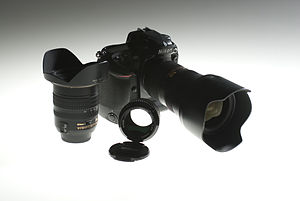Nikon D2Xs
 |
|
| Overview | |
|---|---|
| Type | Digital single-lens reflex camera |
| Lens | |
| Lens | Interchangeable, Nikon F-mount |
| Sensor/Medium | |
| Sensor | 23.7 mm × 15.7 mm CMOS, DX format |
| Maximum resolution | 4,288 × 2,848 (12.2 megapixels) |
| ASA/ISO range | ISO equivalency 100 to 3200 in 1/3, 1/2 or 1.0 EV steps (100–800 only in auto-ISO mode) |
| Storage | CompactFlash (Type I or Type II) |
| Focusing | |
| Focus modes | Single Area AF, Dynamic AF with Focus Tracking and Lock-on, Closest Subject Priority, Group Dynamic AF |
| Focus areas | 11 area TTL (High Speed Cropped: 9 focus areas) |
| Focus bracketing | Eleven sets of focus brackets (area) |
| Exposure/Metering | |
| Exposure modes | Program Auto [P], Shutter-Priority Auto [S], Aperture-Priority Auto [A], Manual [M] |
| Exposure metering | TTL full-aperture exposure metering system |
| Metering modes | 3D Color Matrix Metering II, Center-Weighted, Spot |
| Flash | |
| Flash | n/a |
| Flash bracketing | n/a |
| Shutter | |
| Shutter | Electromagnetically controlled vertical-travel focal-plane shutter |
| Shutter speed range | 30 to 1/8000 second and bulb |
| Continuous shooting | 5 frame/s (RAW/JPEG Fine), 8 frame/s (RAW/JPEG Fine) in HS crop |
| Viewfinder | |
| Viewfinder | Optical-type fixed eye-level pentaprism |
| Image Processing | |
| Custom WB | Auto, presets (5), manual, and color temperature in kelvins |
| WB bracketing | 2 to 9 frames, 10,20,30 MIRED steps |
| General | |
| Rear LCD monitor | 2.5 in (64 mm), 230,000-d |
| Battery | Lithium ion EN-EL4a |
| Optional battery packs | AC adapter EH-6 |
| Weight | 1,070 g (2.36 lb) without batteries, 1,252 g (2.76 lb) with batteries |
| Made in | Japan |
The Nikon D2X is a 12.4-megapixel professional digital single-lens reflex camera (DSLR) that Nikon Corporation announced on September 16, 2004. The D2X was the high-resolution flagship in Nikon's DSLR line until June 2006 when it was supplanted by the D2Xs and, in time, the Nikon D3 range, Nikon D4 range and Nikon D5 — the latter few each using a new FX full-format sensor.
The D2X uses a DX-format CMOS sensor supplied by Sony instead of either a charge-coupled device or the Nikon proprietary LBCAST sensor which had both dominated Nikon's digital SLR lineup until the D2X. The camera supports the sYCC color space. The CMOS sensor used in the D2X has the ability to resolve about nine times more than the human eye. At 90 line pairs/millimeter (90 lp/mm), the sensor can resolve extremely fine detail. This makes the camera perform exceptionally well when used as a landscape or scenic imager, since it can better resolve smaller detail in distant objects.
The D2X surpasses the D2H and its successor the D2Hs by providing 5 frame/s at 12 megapixels, and 8 frames/second at 6.8 megapixels with its high-speed crop mode. In high-speed crop mode, the camera sacrifices pixels in favour of speed and crops the image to 50% of a 35 mm frame to enable continuous shooting at 8 frames per second (vs. 5 frame/s at full resolution).
It incorporates some other innovations such as refinements of the metering and autofocus systems. At the same time, the camera is able to make use of virtually all of Nikon's F-Mount lenses, including most legacy lenses. It has a rated shutter life of 200,000+ images, which is generally double or triple than less costly cameras.
It is one of very few cameras with a built-in "third-eye" which records the color of ambient light, giving the D2X an additional tool to accurately compute the white-balance for each image, instead of relying on calculations based only on subjects within the picture frame.
...
Wikipedia
